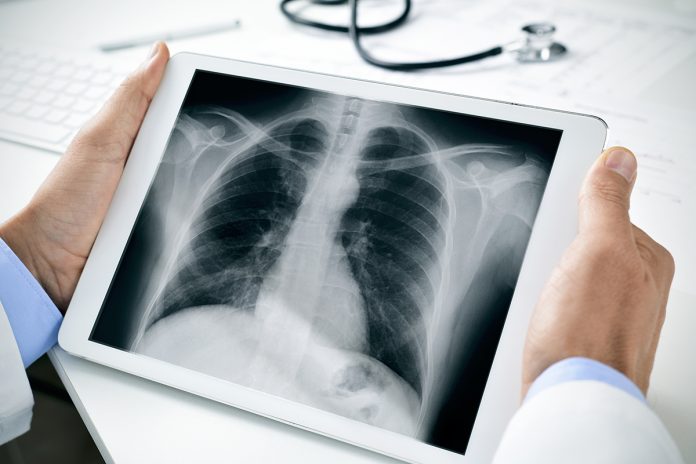Karen Moor and Marlies Wijsenbeek from the Erasmus Medical Center, Rotterdam explore the role of eHealth tools in idiopathic pulmonary fibrosis care and research
Idiopathic pulmonary fibrosis (IPF) is a rare, chronic lung disease with progressive scarring of lung tissue (fibrosis). IPF has a poor prognosis and a devastating impact on the lives of patients and their families. Recently, two anti-fibrotic drugs became available that slow down the decline in lung function (forced vital capacity, FVC) in IPF. Although this is an important and hopeful step forward for patients, IPF remains a deadly disease with a progressively impaired quality of life due to symptoms as dyspnea, cough and reduced exercise tolerance(1).
The use of eHealth technologies could hold great benefits in this elderly population, especially in countries where patients are treated in a limited number of centres and have to travel considerably to visit the outpatient clinic. We believe that eHealth has the potential to improve care and research in IPF as distances are bridged online and data can be collected by the patient at home. The use of eHealth technologies may further promote self-management and provide patients with more insights in their disease course.
Even though the use of eHealth tools to improve health outcomes is being increasingly explored in other (chronic) diseases, experience with eHealth in IPF is scarce. Currently, over 300,000 health apps are available in the app stores, however, most eHealth applications have never been thoroughly investigated.
eHealth is defined as: “The use of information and communication technologies (ICT) for health”(2).
eHealth tools to improve health outcomes in IPF
Together with patients, we have developed a home monitoring programme (IPF online) for patients with IPF. IPF online consists of an app integrated with real-time measurement of lung function at home (home spirometry), online reporting of symptoms, side-effects and quality of life questionnaires, an information library and the possibility of electronic and video consultations(3). This system incorporates automated email alerts if lung function significantly declines or patients report bothersome side-effects. The real-time monitoring and feedback enable patients to gain more insights into their disease and give clinicians the option to monitor patients at a distance. A pilot study with this system demonstrated high patient satisfaction and indicated that online monitoring of lung function and symptoms is feasible and reliable in this elderly patient population. This study has paved the way for a randomised controlled trial evaluating the effect of home monitoring on quality of life, medication use, side-effects and healthcare costs, which is currently underway (NCT03420235).
Use of home monitoring for data collection in clinical trials
Further, eHealth solutions can be used to enhance data collection in clinical trials. One ongoing study evaluates disease behaviour during the peri-diagnostic period in patients with interstitial lung diseases, including IPF, using daily home spirometry and accelerometry. Moreover, this study aims to improve collaboration between community hospitals and expert centres using a digital collaboration platform. The results of this study will shed light on the role of eHealth for earlier diagnosis and treatment(4).
Home spirometry may also facilitate endpoint collection in clinical trials studying new treatment options for IPF and other forms of pulmonary fibrosis. A decline in FVC is the primary outcome in most IPF clinical trials and is widely accepted as a surrogate endpoint for mortality(5). In a rare, progressive disease as IPF, performing large international clinical trials is rather challenging. Studies with new drugs will have to demonstrate efficacy on top of already registered anti-fibrotic treatment. This will lead to smaller margins of change in FVC decline and thereby require a longer duration of studies or larger groups of patients to be studied (increased sample sizes).
Until now, few studies in IPF have focused on the collection of data by the patient at home. Two studies demonstrated that home spirometry in IPF is highly clinically informative and may reduce sample size for future trials(6, 7). These studies clearly revealed the potential of home monitoring in patients with IPF. However, FVC results were not directly available for healthcare providers, which makes it impossible to check the quality of measurements, monitor adherence and timely respond to a decline in lung function. Currently, a number of IPF trials collect home spirometry data as a secondary endpoint, but results have yet to be published.
Though important as an objective outcome measure, lung function does not necessarily reflect how a patient feels or functions. Patient-reported outcomes can provide more relevant information about the impact of a disease on patients’ quality of life and are, therefore, increasingly used as outcome measures in IPF research. One of our recent studies showed that online collection of patient-reported outcomes is feasible for patients with IPF and may be incorporated in eHealth tools(8).
Potential future applications of eHealth in IPF
Multiple national IPF registries have been initiated during the last years, but trans-border collaboration and pooling of data have encountered multiple hurdles so far. An online home monitoring programme has the potential to overcome these barriers, as data about lung function, symptoms, medication and quality of life are collected and owned by patients. These data may be used for registry purposes when patients give their consent. A real-world patient-led registry would provide much-needed insights in disease behaviour of IPF and other forms of pulmonary fibrosis, at a low burden for patients and healthcare providers.
Although recent developments are encouraging, more steps need to be taken in the coming years. For instance, questions about long-term use and cost-effectiveness of eHealth in IPF have still not been answered. Another important issue is whether eHealth solutions could replace outpatient clinic visits in the future and thereby reduce the frequency and burden of hospital visits. To address these topics and integrate eHealth tools in research and clinical practice, better collaboration between patients, healthcare providers, researchers, health policymakers, insurance companies and other stakeholders is needed.
References
1 Lederer DJ, Martinez FJ. N Engl J Med. 2018;378(19):1811-23.
2 World Health Organization. https://www.who.int/ehealth/en/ : WHO; 2019 [
3 Moor CC, Wapenaar M, Miedema JR, et al. Respir Res. 2018;19(1):105.
4 Wijsenbeek M, Bendstrup E, Valenzuela C, et al. Adv Ther. 2019;36(1):232-43.
5 Ley B. Ann Am Thorac Soc. 2017;14(9):1383-4.
6 Russell AM, Ripamonti E, Vancheri C. BMC Pulm Med. 2016;16:10.
7 Johannson KA, Vittinghoff E, Morisset J, et al. Eur Respir J. 2017;50(1).
8 Moor CC, van Manen MJG, Tak NC, et al. Eur Respir J. 2018;51(3).
Please note: This is a commercial profile











